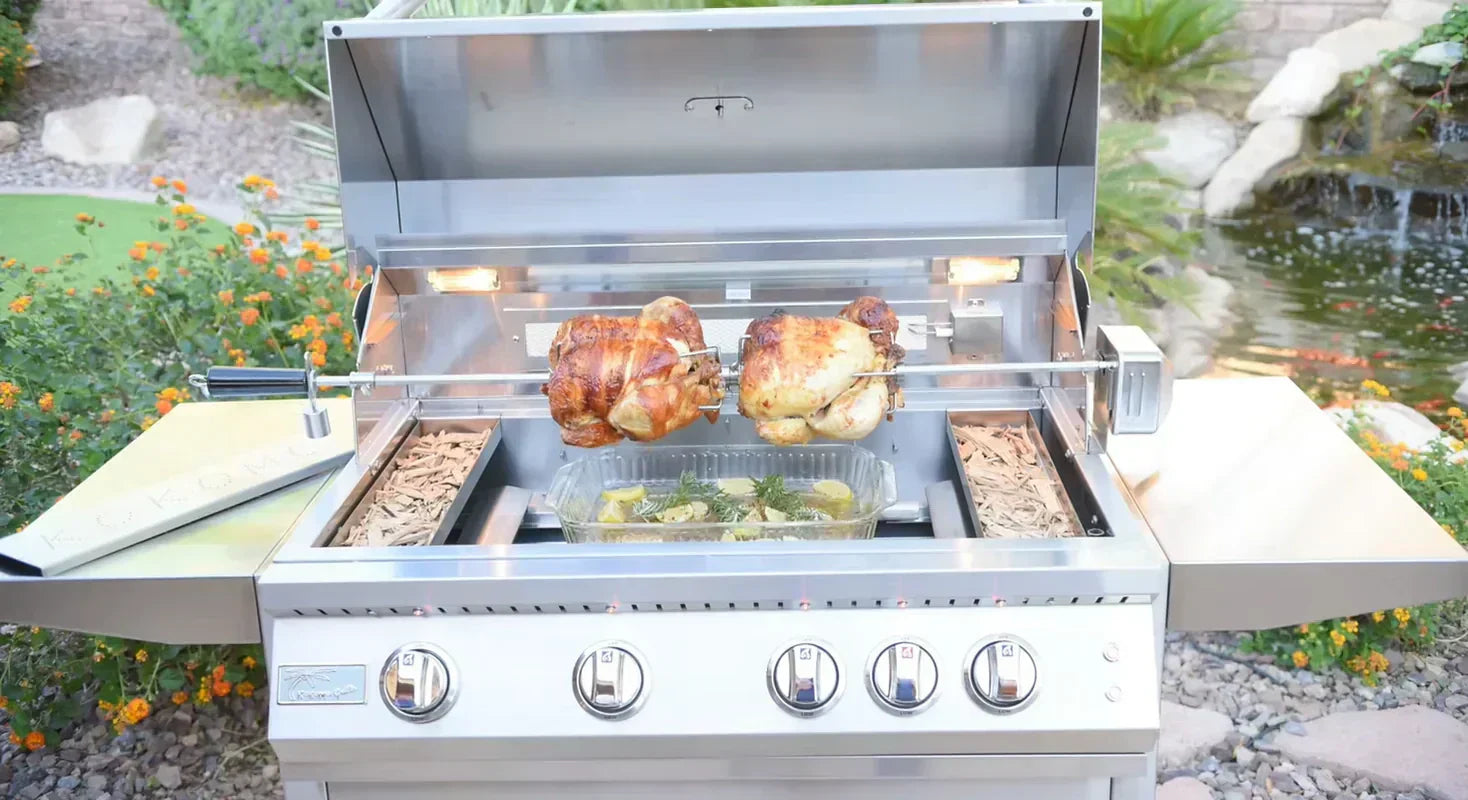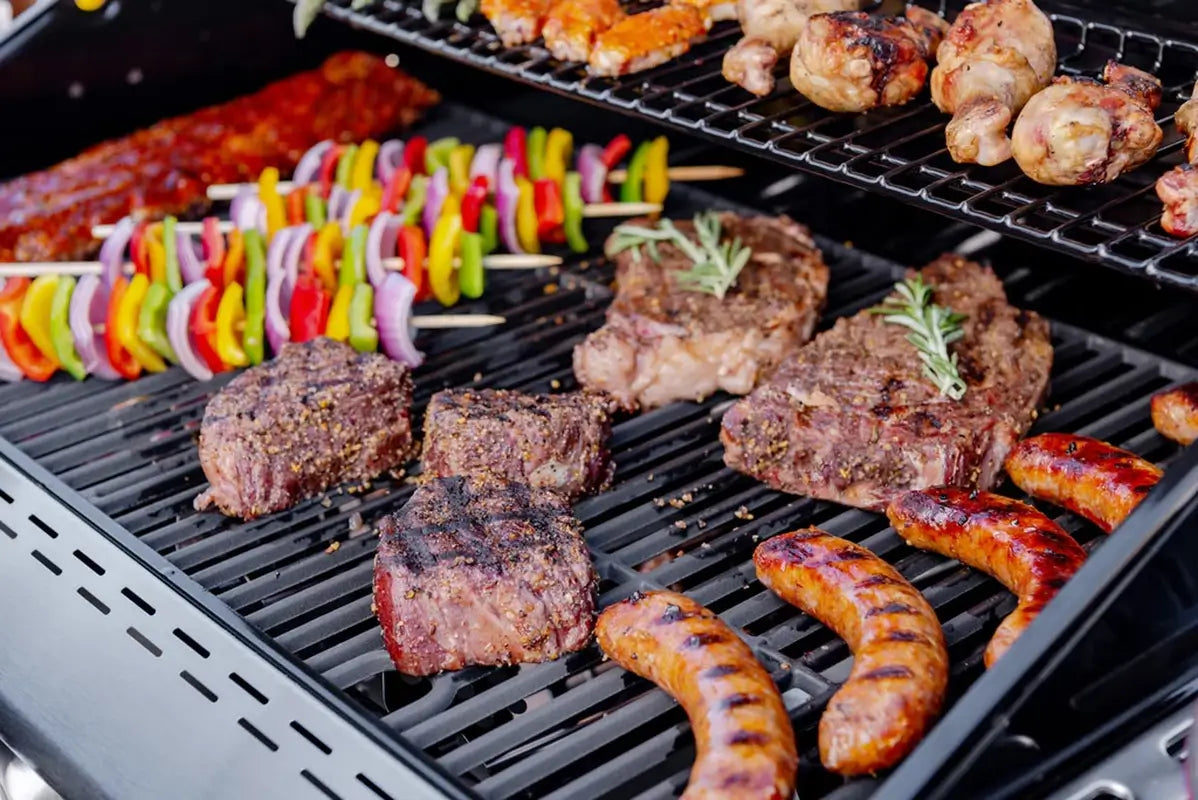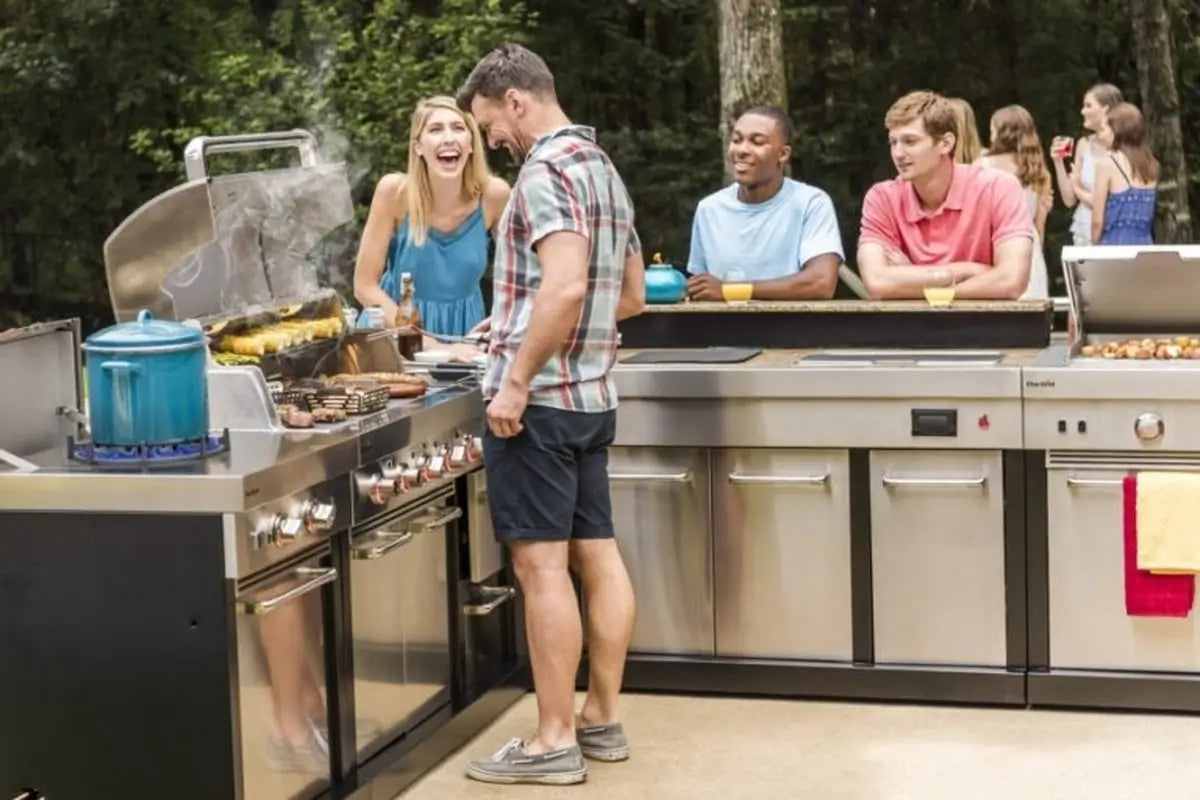
Don’t Buy a BBQ Until You Read This: The Ultimate Grill Buying Guide
Last updated: June 28, 2025
Spend Once, Grill Forever: Your Ultimate BBQ Buying Guide
If you're planning to spend real money on a BBQ grill — the kind that lasts more than just a few summers — this guide is for you. We’ve written it for anyone shopping in the $1,000+ range, looking for something long-lasting, easy to cook with, and worth the investment.
Whether you’re comparing gas grills, charcoal BBQs, pellet grills, or ceramic kamado-style cookers, the right choice comes down to more than just brand names. It’s about build quality, heat performance, ease of cleaning, and whether it fits your cooking style — now and for years to come.

1. Fuel Type: Gas, Charcoal, Pellet, or Electric?
Choosing the right fuel type is the foundation of a great grilling experience. Each type of grill comes with its own cooking style, maintenance needs, and flavor profile — so it’s important to match your choice to how you actually like to cook.
Gas Grills: Fast, Convenient, and Control-Focused
Most buyers shopping in the premium range lean toward gas — and for good reason. Gas grills heat up quickly, offer precision control with easy-to-use knobs, and are extremely convenient for weeknight cooking or entertaining. Premium gas grills often feature:
- Multiple independently controlled burners
- Built-in sear zones and rotisserie burners
- Generous side shelves and enclosed storage
- Heavy-duty stainless steel construction
- Reliable push-button or electronic ignition
Gas is ideal if you want speed, control, and minimal cleanup — all while still getting that impressive grill mark sear.
Charcoal Grills: Classic Flavor and Fire Mastery
If you're after that rich, smoky flavor that screams summer cookout, charcoal is still king. But not all charcoal grills are created equal. In the high-end category, expect features like:
- Adjustable charcoal trays for better heat control
- Built-in thermometers and tight-sealing lids
- Multi-zone charcoal grates for indirect cooking
- Heavy ceramic or double-walled steel construction for insulation
Charcoal grills take longer to heat and require more hands-on attention, but they reward you with deep flavor and an authentic, primal cooking experience. They’re perfect for the griller who enjoys the process as much as the result.
Pellet Grills: Smoke Meets Set-and-Forget Technology
Pellet grills have surged in popularity for good reason — they offer the low-and-slow capabilities of a smoker with the convenience of electronic temperature control. These grills burn compressed hardwood pellets, feeding them through an automatic auger system to maintain a steady cooking temperature. High-end pellet grills often include:
- WiFi and Bluetooth connectivity with app control
- Digital temperature controllers accurate to the degree
- Generous hopper capacity for long cooks (8+ hours)
- True smoking, roasting, baking, and searing zones
Pellet grills shine for slow-cooked meats like brisket, ribs, and pork shoulder, but many can sear steaks and burgers too (especially models with dedicated sear plates or direct flame options). Great for grillers who want consistent results without constant babysitting.
Electric Grills: Fire-Free Flexibility (With Limitations)
Electric grills are best for those with strict fire code limitations — such as condo balconies or indoor grilling needs. They plug into a standard outlet and heat up quickly, but their cooking performance and flavor fall short of gas, charcoal, or pellet options. That said, premium electric grills may offer:
- Ceramic infrared heating for better searing
- Digital heat controls
- Easy indoor-outdoor portability
- Quick cleaning and minimal smoke
They’re not ideal for traditional BBQ flavor, but they’re a functional solution when open flame isn’t an option.
2. Build Materials: What Makes a Grill Last?
The materials used — both outside and inside — are what separate a short-lived grill from one that performs flawlessly for 10+ years.
304 Stainless Steel: The Gold Standard
304-grade stainless steel is the industry benchmark. It resists rust, corrosion, and heat damage — even in coastal or humid environments. Look for:
- Double-walled construction for heat retention and structure
- Welded seams (not rivets or screws)
- Full-body 304 stainless — not just on the lid or faceplate
Burners: Where Brands Cut Corners
- 304 stainless or cast stainless burners are ideal
- Brass burners are also excellent and corrosion-resistant
- Flimsy aluminum or stamped steel burners are deal-breakers
Grates: Heat Holding and Durability
- Cast iron grates = better searing, but need seasoning
- Thick stainless steel rod grates = low maintenance and durable
Flame Tamers / Radiant Shields
- Stainless steel plates or ceramic briquettes improve heat distribution
- They vaporize drippings and reduce flare-ups while protecting burners
Ceramic Bodies: Kamado-Style
Ceramic kamado-style grills like Kamado Joe offer outstanding insulation, moisture retention, and fuel efficiency. They can reach searing temps or hold steady for 12+ hour smokes. Just handle them with care — ceramics can crack if dropped or thermally shocked.

3. Heat Output and Control
Anyone can crank the burners — but high-end grills are about heat control. Searing, smoking, roasting, and baking all demand precision. Here’s what matters:
- Even heat distribution: Premium grills eliminate hot spots with better burners, flame tamers, and insulated fireboxes
- True high heat: 600–700°F minimum on the main burners
- Dedicated sear zones: Infrared burners hitting 900°F+ for steakhouse crusts
- Multi-zone cooking: Independent control lets you grill burgers while roasting veggies
- Heat retention: Thicker lids and double-walled fireboxes maintain temperature and reduce fuel waste
- Instant responsiveness: Smooth-turning knobs and fast ignition mean no temperature guessing games
At this level, precision isn't a luxury — it's the standard.
4. Grilling Space and Layout
It’s not just about square inches — it’s about how usable and smart the cooking space is. A premium grill should feel like a chef’s station, not just a big box of heat.
How Much Space Do You Really Need?
- 2–3 people: 300 sq. in.
- 4–6 people: 400–600 sq. in.
- 6+ or entertainers: 700+ sq. in.
That’s just for the main grate. The smart layout features — warming racks, sear zones, and side burners — make the difference.
Warming Rack: Not an Afterthought
Look for adjustable or full-width warming racks that offer a second level of cooking. They’re perfect for toasting buns, finishing steaks, or keeping vegetables hot while you rest your protein.
Dedicated Sear Zone
A dedicated searing area — especially infrared — means you can get a steakhouse-quality crust without overcooking the rest of your food. Built-in sear zones are a sign of serious grill engineering.
Built-In vs. Add-On Flexibility
Some high-end grills include these zones, while others support drop-in accessories (griddles, smoker boxes, rotisseries). Either way, your grill should adapt to how you cook — not the other way around.
---5. Ease of Cleaning: The Hidden Dealbreaker
Even the best grill becomes a chore if it’s messy and time-consuming to clean. This is where budget grills fall apart — literally.
What Cheap Grills Get Wrong
- Tiny rear grease traps that spill over
- Flimsy flame tamers that collect gunk and rust
- Fireboxes that are hard to reach and filled with soot
- Painted interiors that flake under heat and grease
What High-End Grills Do Right
- Full-width front-access grease trays: Easy to slide out and clean
- Self-vaporizing flame tamers: Reduce grease and flare-ups
- Removable firebox liners: No tools required
- Porcelain or stainless interiors: Easy to wipe down
- Charcoal ash trays: Slide out smoothly — no scooping with a spoon
If cleaning is the part you dread most, a premium grill will save you hours of hassle each season. The difference is night and day.

6. Cooking Versatility: More Than Just Burgers
When you invest in a high-end grill, you’re not just getting a better version of a basic grill — you’re getting a multi-function outdoor cooking system. Think chef-level performance without the indoor heat.
Why Versatility Matters
Premium grills let you cook a full meal — meats, sides, even desserts — all in one place. That’s not just convenient, it’s the difference between grilling and outdoor cooking.
What to Expect from a Versatile Grill
- Low-and-slow smoking: Rear burners, smoker boxes, or charcoal trays let you tackle ribs and brisket
- Infrared searing: For steakhouse-quality crusts on steaks, lamb, and chops
- Multi-zone management: Cook veggies at 350°F while searing at 750°F on the same grill
- Griddles and stones: Smash burgers, pancakes, flatbreads, even cookies
- Rotisserie kits: Chicken, pork loin, or whole fish — evenly cooked, hands-free
Built-In vs. Modular Tools
Some grills come with these tools built in. Others allow you to add them as needed. Either way, the grill should function like an outdoor kitchen workstation, not just a hot metal box.

7. Freestanding vs. Built-In: Know Your Space and Future Plans
This choice seems simple — but it plays a big role in how your outdoor space functions. Think about your lifestyle now, and how you might upgrade later.
Freestanding Grills
Mounted on a wheeled cart, these are flexible, portable, and great for renters or seasonal users. Premium freestanding models often include enclosed storage, side shelves, and optional conversion kits.
Built-In Grills
These are designed to be the heart of an outdoor kitchen. Permanent, seamless, and surrounded by countertops and cabinetry, they’re perfect for entertainers who want a full outdoor cooking space.
Can’t Decide?
Some brands (like KoKoMo) offer conversion-ready models. Start freestanding, then build it in later when your patio evolves.
---8. Tech Features — Worth It?
Tech shouldn’t get in the way — it should make your grilling smarter, not more complicated. The best modern grills strike that balance.
Common Tech Features in Premium Grills
- WiFi and Bluetooth thermometers
- App-based temperature control and timers
- Digital readouts for exact temperature monitoring
- LED-lit knobs and interior grill lights for night grilling
When It’s Worth It
If the tech enhances your workflow — especially for long smoking sessions or multi-dish meals — it’s a great upgrade. But if it’s clunky or unreliable, it can be more frustration than help.
Example: Kamado Joe’s iKamand controller adds true set-it-and-forget-it functionality to a manual charcoal cooker. Smart, useful, and well-designed — that’s what tech in a grill should be.
---9. Warranty & Brand Support: Built to Last, Backed for Life
Premium grills cost more because they’re built better — thicker steel, cast components, commercial-grade ignition systems. But even the best materials can fail. That’s where warranty comes in.
Think of warranty like insurance — you hope you’ll never use it, but it’s peace of mind when something goes wrong. High-end brands typically offer:
- Lifetime warranties on the cookbox and burners
- 5–10 years on flame tamers, ignition systems, and grates
- Customer support that actually responds and stocks replacement parts
KoKoMo Grills, for example, offers lifetime warranties on key components and long-term service support. That’s the kind of brand you want in your corner.
---10. Final Checklist Before You Buy
Before you commit, pause and think about how you really grill. Use these questions to guide your final decision:
- Do I prefer gas, charcoal, pellet, or electric?
- How many people do I regularly cook for?
- Do I want freestanding now, or am I building a full outdoor kitchen?
- Am I the type to clean regularly — or will ease of maintenance save me stress?
- Will I use searing, smoking, rotisserie, or tech features?
- Is warranty and brand support strong enough to back this investment?

Looking for a Long-Term Investment?
If you’re in the market for a premium grill, one standout brand we carry is KoKoMo Grills. They focus on build quality, cleaning convenience, and reliable performance — not flashy gimmicks.
Available now at Deck and Den:
- KoKoMo 3-Burner Built-In Gas Grill
- KoKoMo 4-Burner Freestanding Cart Grill
- KoKoMo 5-Burner BBQ with Infrared Zone
All KoKoMo models use 304 stainless steel, cast iron grates, and include a lifetime warranty on the cookbox and burners. Select models are on limited-time promotion while supplies last.
---Ready to Explore Premium Options?
At Deck and Den, we focus on grills that deliver long-term value and exceptional performance. Whether you're early in your research or ready to buy, our team is here to help you make the right choice.
Browse our premium grill collection today — and feel confident you’re buying a BBQ built to last. Have questions or eyeing a specific unit? Give us a call — we’re happy to help and may even be able to offer a special discount.


Leave a comment